You might be wondering, is chayote keto? Absolutely! As you go down a ketogenic diet, you start to dive into a world of culinary creativity, especially when it comes to finding substitutes for beloved fruits and vegetables that may not fit the keto macros.
Let’s learn more about an intriguing contender in the keto-friendly produce section: the chayote squash. This unique, often overlooked vegetable could be your next go-to ingredient for keeping your meals exciting and your carbohydrate count low. We're about to explore why, along with how to incorporate it into your diet!
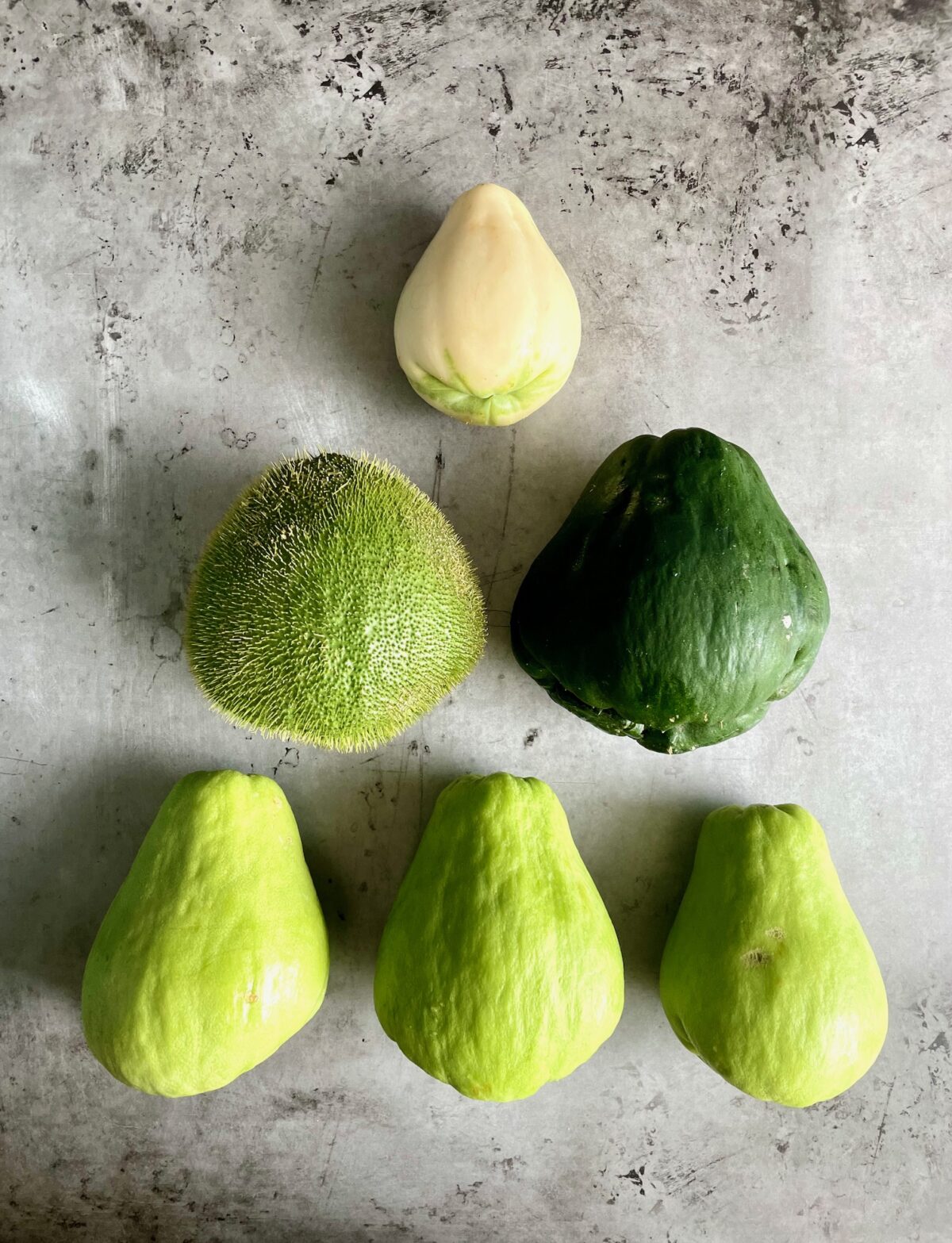
Jump to:
- What is chayote: The keto-friendly Mexican green squash
- Chayote uses worldwide
- Common names for chayotes
- Culinary uses in Louisiana
- Culinary uses in Mexico and Latin America
- Culinary uses in Mauritian cuisine
- Nutritional benefits of Mexican squash for a keto diet
- How to incorporate chayote in a ketogenic diet
- High protein and low carb chayote keto meal ideas
- Creative substitutions and tips for choko
- Where to buy chayote?
- Is chayote keto or low-carb friendly?
- Related articles
What is chayote: The keto-friendly Mexican green squash
The chayote squash, scientifically known as Sechium edule, is a member of the gourd family and is native to what we now know as Mexico and Central America. Technically a fruit since it encloses a seed, chayote is a thin-skinned pear-shaped vegetable with a very mild flavor and a crunchy texture. It's a fantastic substitute for higher-carb fruits and vegetables as it acts as a blank canvas. This succulent and tropical keto-friendly fruit has a flavor reminiscent of cucumber.
There are two varieties of Mexican chayote squash: smooth and prickly, and the prickly ones are super spiky! The most common one is the light green skin chayote, usually with smooth skin. But you might be surprised to find out that there's a nice variety of these Aubrey II-looking veggies!
In Mexico and Southern America, you can easily find the white chayote, green chayote, and the prickly chayote. Their skin also varies greatly from baby smooth to deeply wrinkled.
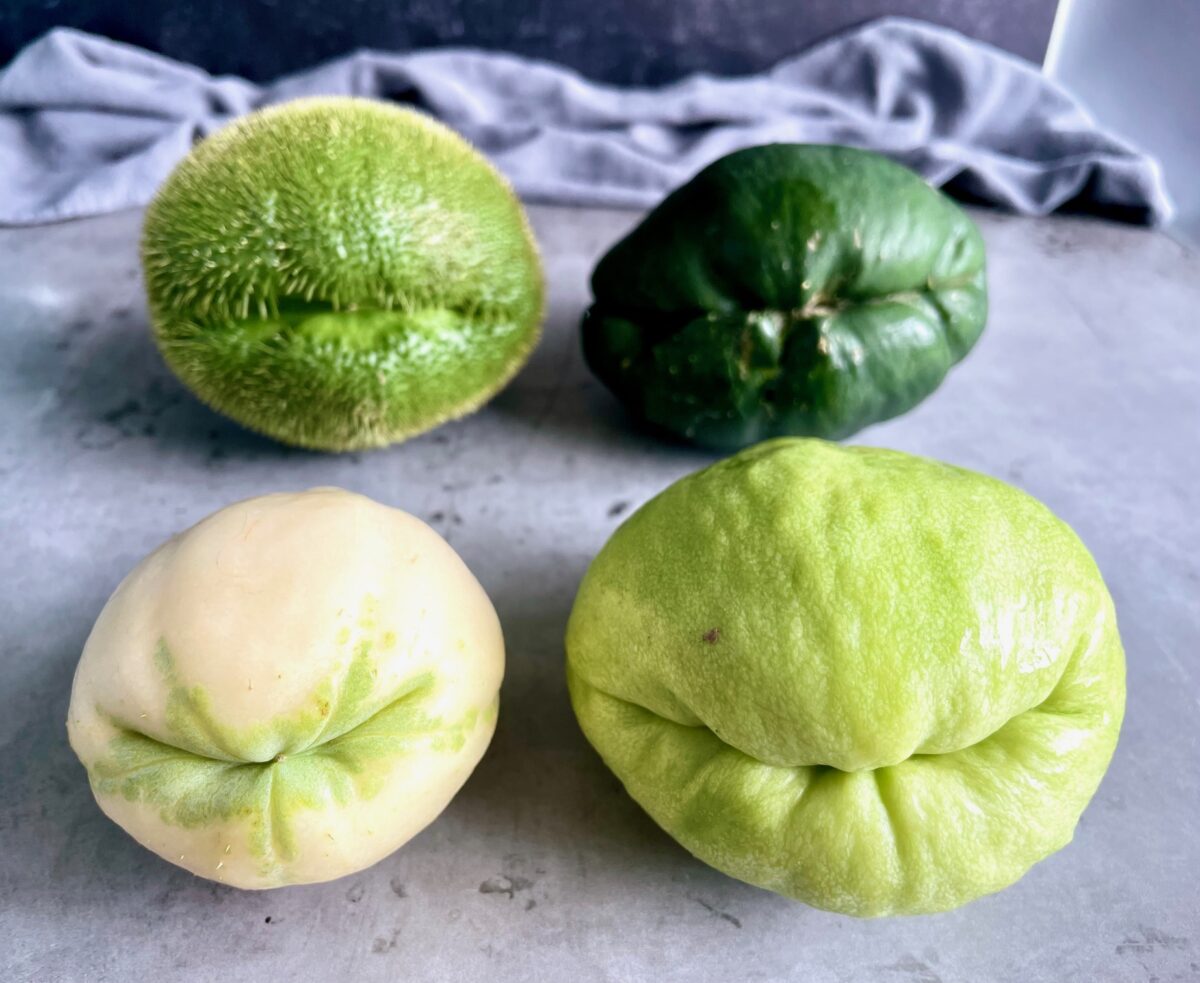
I live in Los Angeles where we have access to all of them. I've done a taste test, and I can tell you there's no real difference in taste. I think they look pretty cool and the white ones were my favorite to handle: small, easy to peel and de-seed.
Funny side story: I've seen my fair share of prickly chayote squash (they vary in prickliness), but when I first came across the super prickly one at my local Mexican store, Vallarta, I might or might not have let out a swear word when I got pricked despite being super careful, possibly startling a few customers around me... whoops.
Here is the prick:

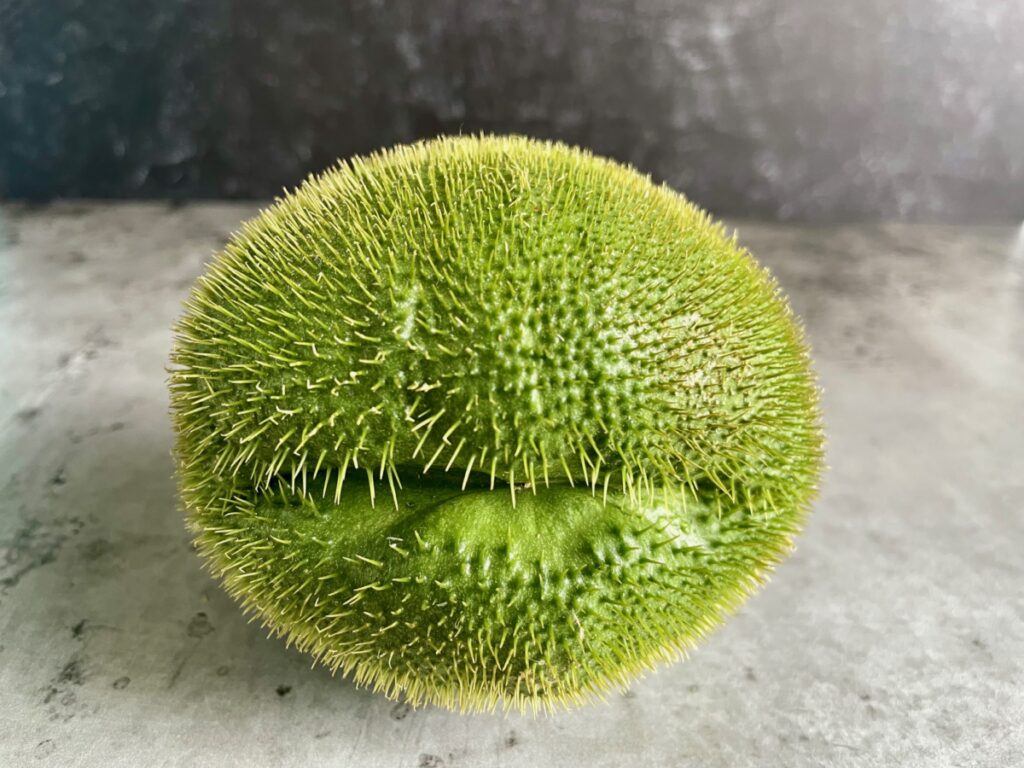
Left picture: prickly chayote squash on supermarket shelves (at Vallarta)
Right picture: Close-up of prickly chayote
Chayote uses worldwide
Despite its extensive use in the Americas and in Asian and Southeast Asian cuisines, chayote remains relatively unknown in the US and most Western countries. One major exception is the Southwestern American states of California (southern), Arizona, New Mexico, Texas, and Louisiana due to their proximity to Central America.
It might be surprising to learn that all parts of the fruit are edible, including the seeds and the leaves!
Common names for chayotes
Australia and Singapore: choko
China: foshugua
India: chow chow
Jamaica: chocho or cho cho
Mauritius: chouchou or chou chou
Philippines: sayote
United Kingdom: christophine
United States: Chayote or Mirliton (in some states like Louisiana)
Culinary uses in Louisiana
In Louisiana, chayotes, more commonly known as mirliton (pronounced "MEL-a-tahn") or vegetable pear, are an integral part of their cookery. This veggie is so cherished that you can't have Thanksgiving or Christmas dinner without mirliton as the supporting star!
Some popular Louisiana chayote dishes are crawfish-stuffed mirliton and casseroles. You might be surprised that it's used in dessert recipes like the Mirliton pudding, which is composed of pecans, raisins, brown sugar, and warming spices like cinnamon and nutmeg! It's a fantastic apple substitute!
In Cajun country, or Arcadiana, the most popular way to use chayotes is in a pork stuffing or seafood dressing and I don't mean salad dressing! Merriam-Webster defines dressing as "a seasoned mixture usually used as a stuffing (as for poultry)".
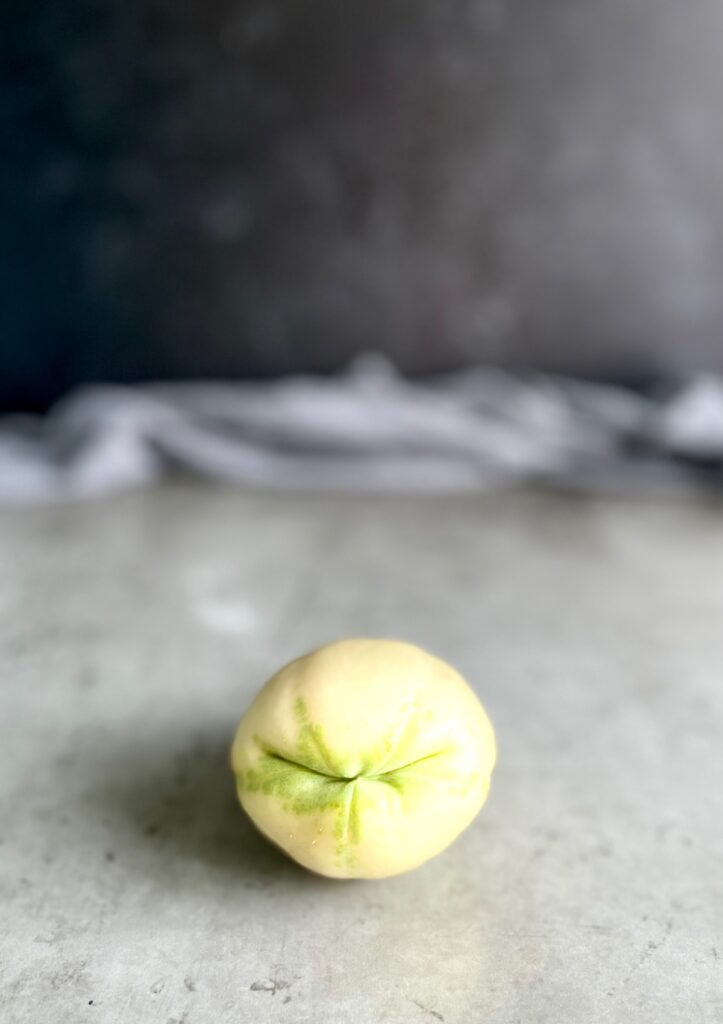
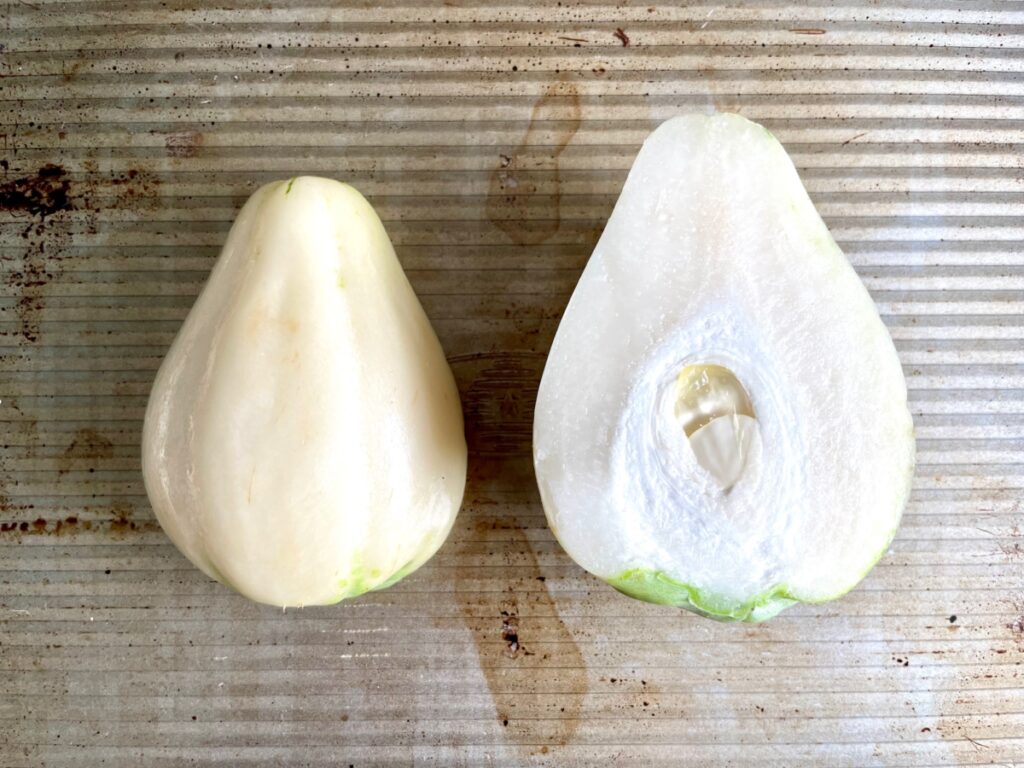
Culinary uses in Mexico and Latin America
In Mexico and its neighbors to the south, chayote uses are vast and wide and are deep-rooted in ancient cookery. There, chayote is considered an old-world food that was consumed long before Mexico was even Mexico.
In fact, if we get really technical, or for those historically inclined, chayotes were part of Mesoamerica, an ancient region that has now been divided into several countries, what we now know as Mexico, Honduras, Guatemala, and more.
The most common culinary uses in the Americas are:
Soups and stews
Soups and stews are by far the most popular way to use these economical squashes. Pork, chayote, and green chile stew are a favorite, and another popular one is brothy beef or chicken and vegetable soup, which is often paired with zucchini or sliced corn on the cob.
In Los Angeles, we have a famous Mexican restaurant called Guelaguetza. Devoted primarily to Oaxacan cuisine and beloved by the late Los Angeles Times restaurant critic, Jonathan Gold, Guelaguetza serves a very simple soup called Caldo de Pollo, which is essentially a light chicken soup with sliced chayote with the skin intact. I get this dish every time I visit the restaurant. It's comfort food perfection!
Steamed, sautéed, or stuffed
Chayotes are also enjoyed in simple forms like steamed or sautéed and then tossed with cilantro, cumin, and jalapenos. Another popular way to enjoy them is stuffed with veggies and/or egg and cheese.
Salads
In summer, salads like a jícama, pineapple, and chayote combination are another favorite way to enjoy this keto-friendly veggie.
Culinary uses in Mauritian cuisine
I'm including Mauritian uses in this section as I'm quite partial to chayote myself, as it's widely used in my country, Mauritius, where the plant thrives due to the tropical climate.
Edible chayote leaves
We even use the chayote leaves in brothy soups that accompany lentil and/or rice dishes. It is also common for Mauritians to sauté chayote leaves with dried whole red chilies, garlic, and ginger serve it as a side with our main dishes.
Stir-fried chayote squash
Another common use is stir-fried chayote with ginger and ground pork or ground chicken added. We also marinate thinly sliced beef pieces in soy sauce and cornstarch before stir-frying them with thinly sliced chayote squash.
Chinese Chayote Dumplings
Last but not least is every Mauritian's favorite chayote recipe: Boulette Chouchou. Boulette chouchou is a Hakka-Chinese steamed chayote dumpling that is sold at almost every street corner and in little eateries across the island. They are served with a generous amount of Homestyle Chinese Red Chili Paste or Mazavaroo Chili Paste.
Nutritional benefits of Mexican squash for a keto diet
Beyond its low carb count, chayote is a nutritional powerhouse. It's a good source of vitamin C, essential for immune system health, and vitamins B6 and B9, which support energy metabolism and the female reproductive organs.
Its high fiber content aids in digestion and can help maintain stable blood sugar levels, a crucial aspect of the ketogenic diet. Chayote also contains minerals such as potassium and magnesium, all of which play important roles in maintaining overall health.
While chayote is generally well-tolerated, those with specific health conditions should consult with a healthcare provider before making significant changes to their diet, especially when introducing new foods.
To learn more about the nutritional facts of chayote, check out this Very Well Fit article.
How to incorporate chayote in a ketogenic diet
Chayote's low net carb content is extremely exciting for those on a ketogenic diet as it paves the way for a cornucopia of keto recipes that would otherwise use higher carbs, vegetables, or fruits.
Chayote can easily fit into your daily carb limit with only about 4.5 g net carbs per 100 g serving. To top it all, it's easy on the wallet as it's one of the cheapest vegetables. No wonder it's gaining in popularity in the keto community!
One of the reasons I listed the many ways the different cultures worldwide use chayotes is so that you can draw inspiration from them if you want to incorporate this great low-carb vegetable in your veggie rotation.
Use it as you would use zucchini or any other summer squash
If chayotes are new to you, I recommend using them either with or in lieu of zucchini or other summer squashes like pattypan, crookneck or yellow squash, and tatume or calabacita.
Substitute it for apples in breakfast or dessert recipes
A favorite way for the keto community to use chayote is as a stand-in for apples, especially in satisfying breakfast and dessert recipes! Substitute chayote for apples, adding lemon or lime juice and a bit of apple extract to mimic the flavor of apples.
Now you can bite into guilt-free desserts like keto pie recipes made with a delicious chayote filling.
High protein and low carb chayote keto meal ideas
Chayote's mild flavor and crunchy texture make it a versatile ingredient in the kitchen. It can be used raw in salads, boiled, steamed, or even stuffed. Here are some creative and satisfying keto-friendly ways to enjoy chayote.
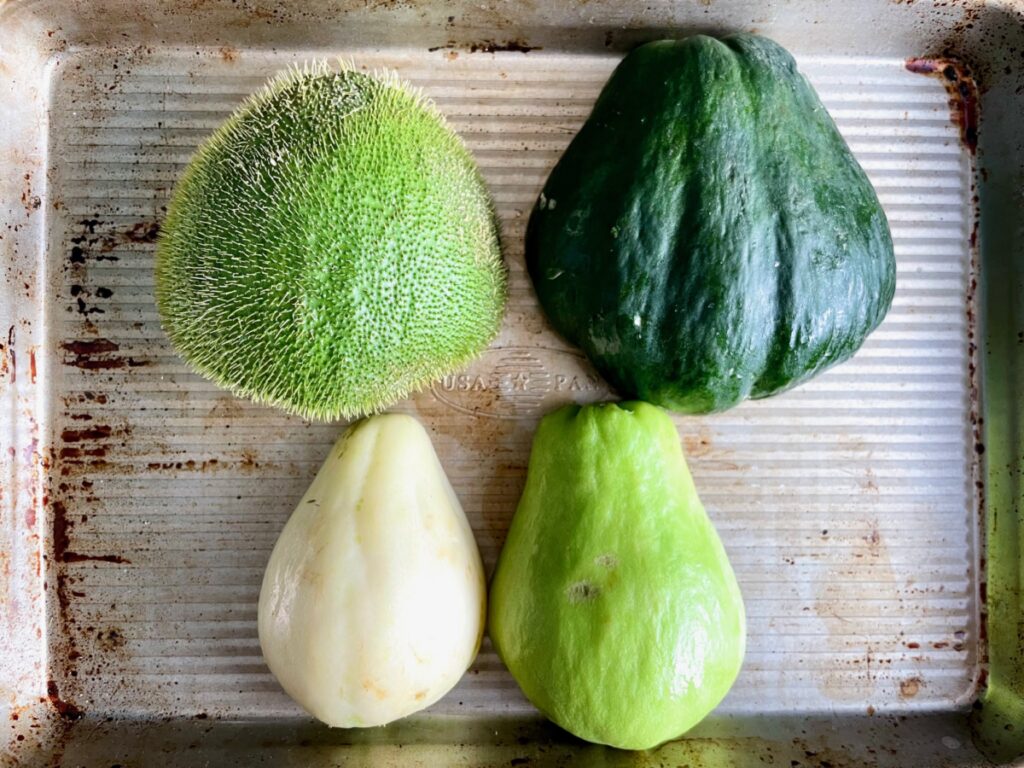
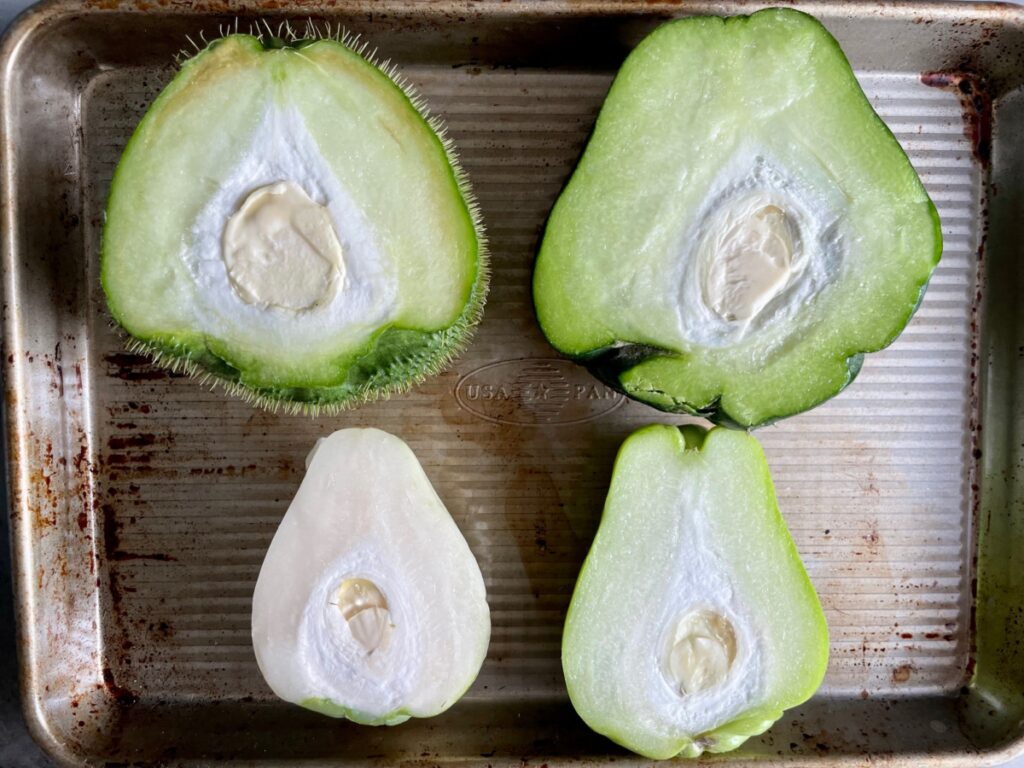
Breakfast
- Scrambled eggs with thinly sliced chayote, cheddar, and topped with chives.
- Turkey bacon, chayote and chopped bell peppers frittata
Main meals
- Stuffed chayotes. Chayotes stuffed with ground protein and topped with cheese and/or turkey bacon. Hollow out chayote halves and fill them with a mixture of meat, cheese, and spices. Bake until fork tender for a delicious and complete low-carb meal.
- Chayote casserole. Mix diced chayote with cream, cheese, and chopped bacon for a satisfying casserole dish that is perfect for a cozy night in.
- Stews or soups. Chicken and chayote stew topped with sour cream is a delicious way to feature chayote. Another popular soup is Mexican beef soup with chayote and other chopped vegetables.
Sides and salads
- Chayote au gratin or scalloped chayotes. Thinly slice chayotes and layer them with cream, cheese, and herbs for a keto take on the classic gratin.
- Chayote salads. Thinly slice chayote and mix with your choice of greens, protein, and dressing for a refreshing and filling salad option. And why not pair it with jícama, another great Mexican low-carb vegetable? You can use either raw or cooked chayote for the salads.
- Grilled chayote. Thickly slice chayote and grill until just tender for a simple yet flavorful side dish. Sprinkle the slices with parmesan cheese and thyme, or drizzle with balsamic vinegar for added flavor.
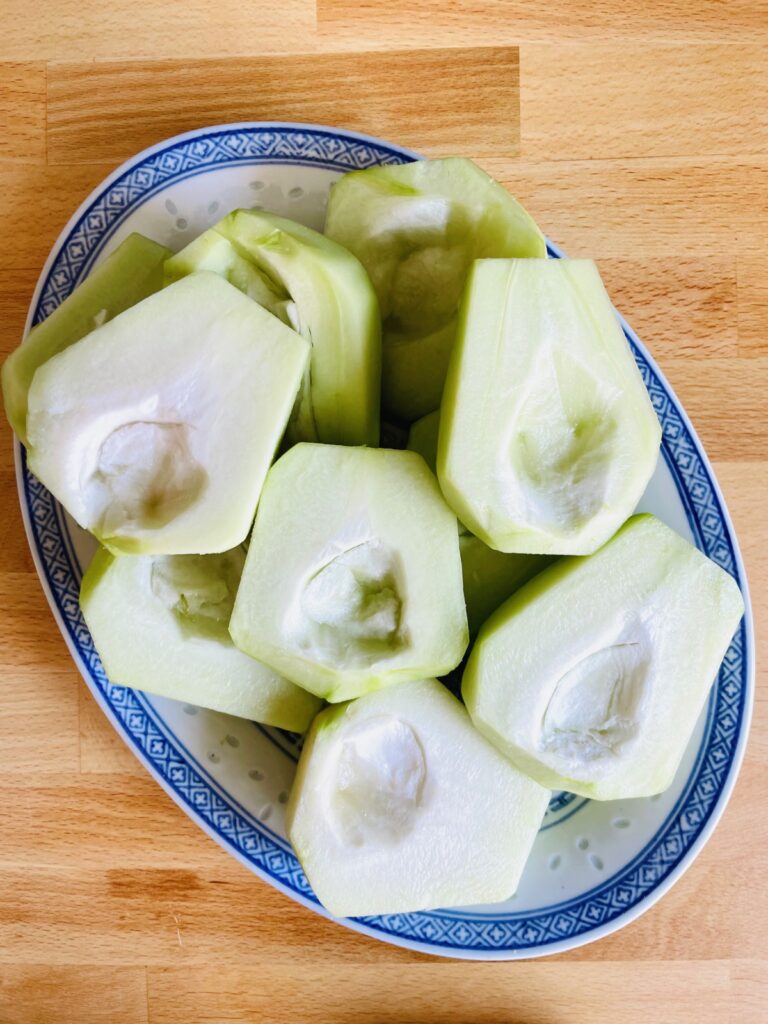

Desserts
- Mock apple pie. Use chayote in place of apples in your favorite apple pie recipe, adjusting the sweetness and adding cinnamon and lemon juice to achieve that classic apple pie taste. Top with a keto-friendly pie crust for a tasty and guilt-free treat. A little keto kitchen tip for you: use coconut flour to thicken your chayote filling!
- Keto mock apple crumble. Sweeten with your choice of keto-friendly sweetener, and use almond flour instead of regular flour or oatmeal for a delicious crumble.
- Poached cinnamon "apples." I love topping these with chopped pecans or walnuts, both an excellent source of protein and omega-3 fats, which help lower the risk of heart disease and boost brain health.
Snacks
- Keto "apple" crisp. You can use dehydrator, traditional oven or an air fryer to make these tasty snacks!
- Chayote chips. Thinly slice chayote and toss in olive oil or ghee, salt, and your choice of seasonings. Bake until crispy for a low-carb alternative to potato chips.
- Chayote juice or smoothie. Chayotes can be juiced! If you don't have a juicer, you can add chayote to your favorite smoothie recipe for an extra boost of vitamins and minerals. It adds a subtle sweetness without adding too many carbs.
- Pickled chayote. In Mauritius, we pickle chayote with a simple mix of vinegar, salt and sometimes even chili peppers for a little kick!
Other
- Chayote noodles. Spiralize chayote into noodles and use them in place of traditional pasta. Serve with your favorite keto-friendly sauce for a healthy and delicious meal option.
Creative substitutions and tips for choko
When using chayote as a substitute in recipes, keep in mind that it will absorb the flavors of the ingredients it's cooked with. This characteristic makes it an excellent base for both sweet and savory dishes.
Here are a few tips for getting the best results:
- Acid and Sweetener: Adding lemon or lime juice along with a sugar substitute can help chayote mimic the taste of more sugary fruits like apples.
- Texture Adjustments: Depending on the recipe, you may need to adjust cooking times to achieve the desired texture, as chayote can be crunchier than some fruits.
- Experiment: Don't be afraid to use chayote in a variety of dishes. Its mild flavor and texture make it an excellent candidate for experimentation in the kitchen.
Where to buy chayote?
If you live in a part of the country where chayote isn't commonly available, your best chance of finding it is at any Latin, Asian, or Indian grocery store.
In some Southern states of America particularly California (southern), Arizona, New Mexico, Texas, and Louisiana, chayote squashes are widely available in most grocery stores due to their proximity to Central America.
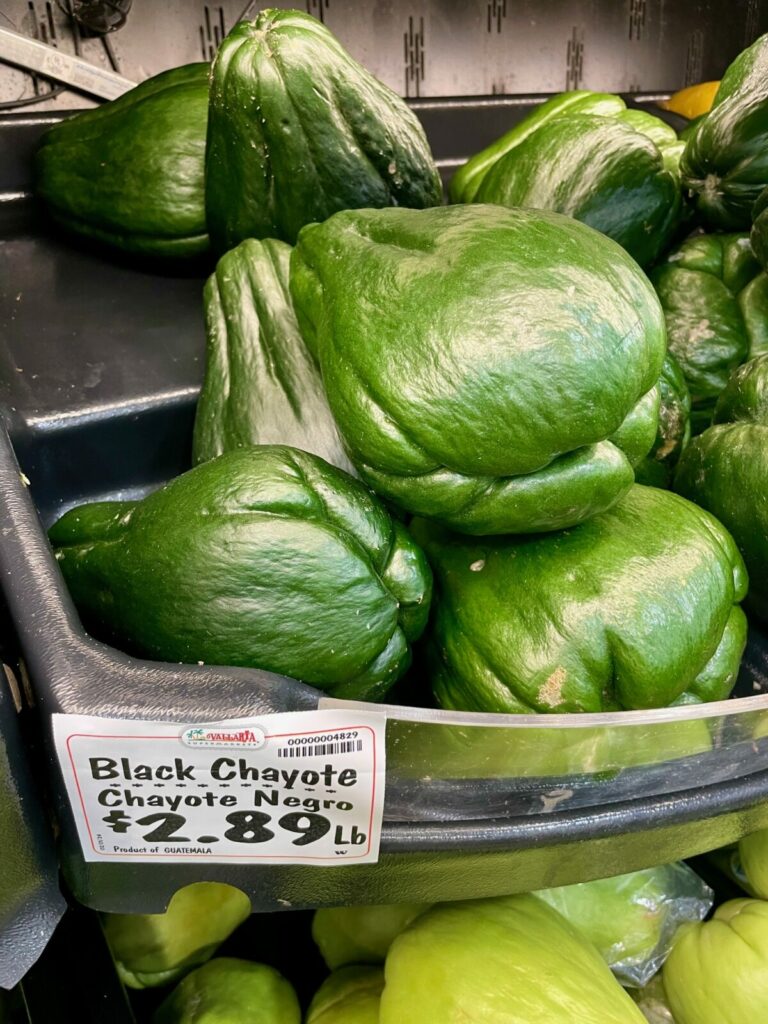
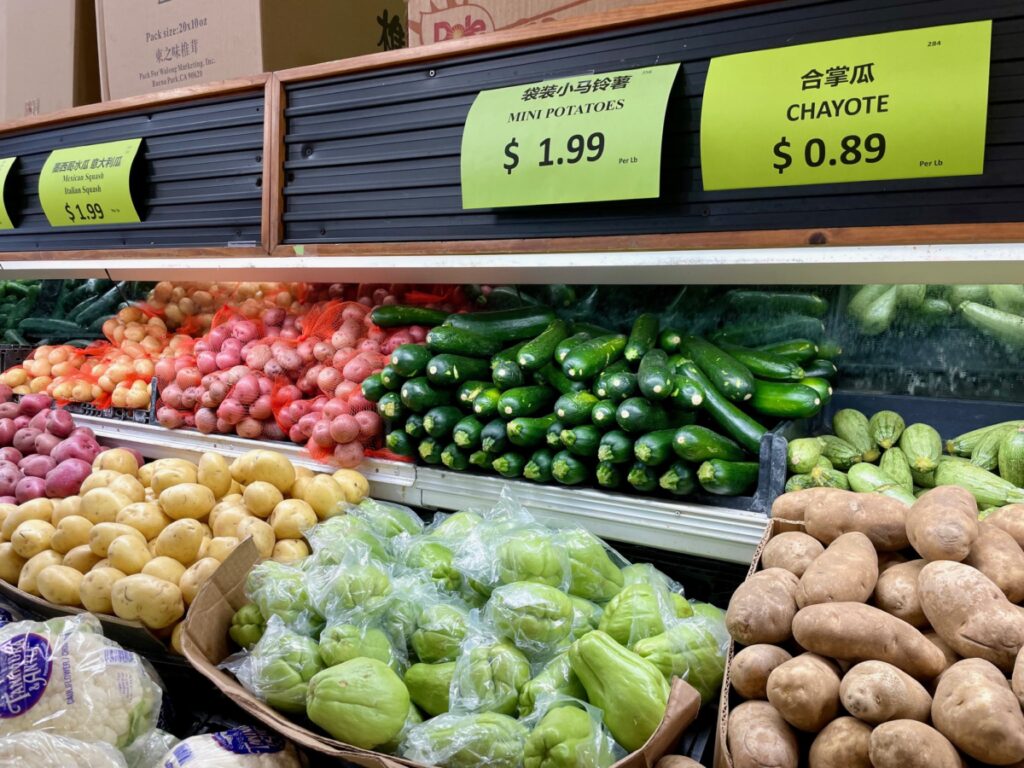
Is chayote keto or low-carb friendly?
Chayote’s versatility in the kitchen allows for a wide range of keto-friendly culinary applications, from mock apple pies to gratins, making it an excellent addition to your low-carb recipe arsenal.
Next time you're at the grocery or specialty store, consider picking up a chayote squash and experimenting with this fantastic keto-friendly vegetable. Not only will your taste buds thank you, but you'll also reap the numerous health benefits that this unique vegetable has to offer!
Related articles
Since you're on a keto journey, you might also be diving into the beautiful world of ghee: a nutritious high-fat and low-carb ingredient perfect for a keto diet. You might like to peruse my Is Ghee Ok for Dairy Allergy article where you'll discover its many uses.
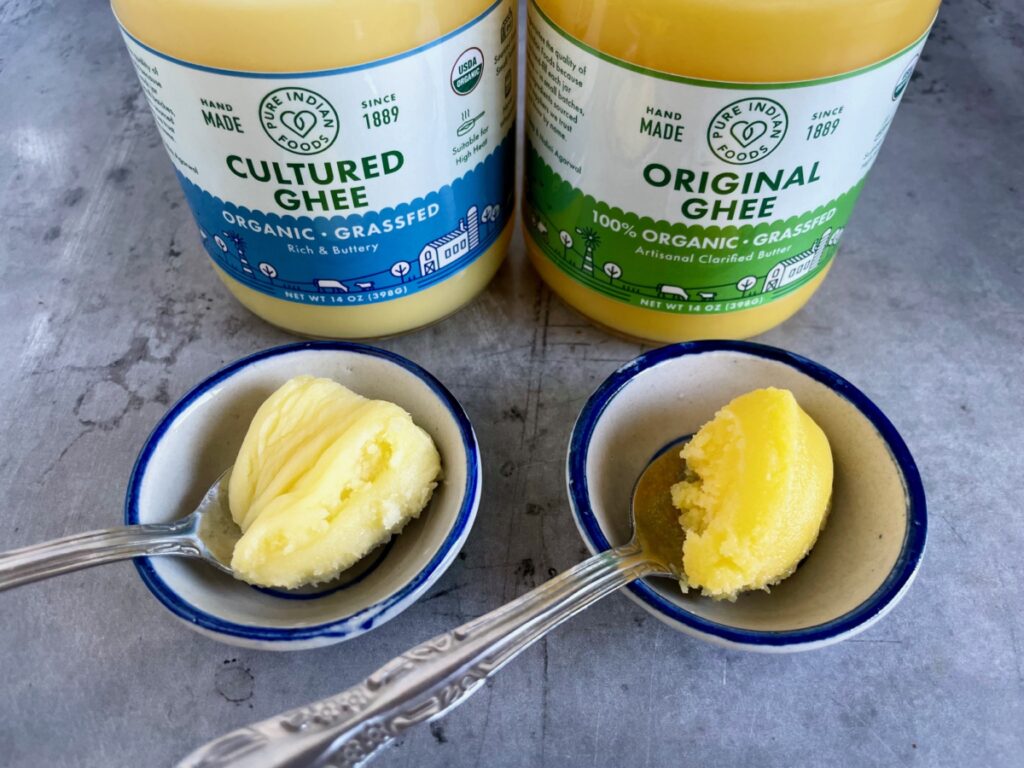


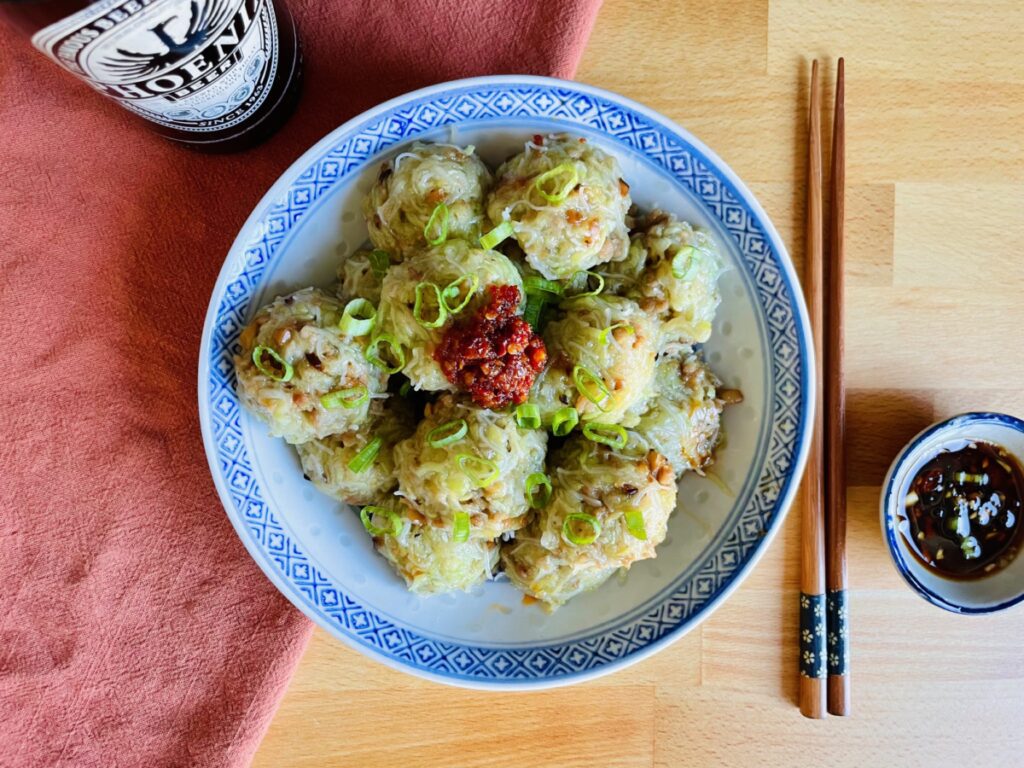
Clara FernandezChapin
thanks for this great article. I'm not keto but I am very low carb. I enjoy big salads and try new items in them for variety and nutrition. I will be happy to find more of your helpful information.
Eliette Stall
Hi Clara,
Thank you very much. I'm so glad you enjoyed the chayote article and found it helpful! 🙂